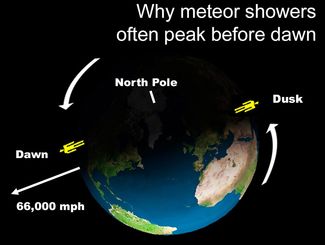The Sky is Falling!
Last updated 8/4/2016 at 6:42am
Few sights are as thrilling as the fiery spectacle known as a falling star, also called a shooting star or meteor. Astronomers cannot predict exactly when or where a meteor will appear, but sky watchers head far from the city lights during mid-August each year to view one of the year's most reliable displays: the Perseid meteor shower.
This year will be no exception. The shower's peak will occur on the night of Thursday, Aug. 11 and the pre-dawn hours of Friday, Aug. 12, but you will see early meteors from this shower throughout the weekend.
Often a bright meteor will start my phone ringing, as people are stunned by the sight. But they are not all that uncommon. Our region of space is littered with dusty particles called "meteoroids," most no larger than a grain of sand. As one slams into our upper atmosphere at more than 100,000 miles per hour, it disintegrates in a quick, but dramatic burst of light. On a clear, dark night an observer can typically see three or four random (or "sporadic") meteors every hour, falling from various directions.
There are times when our odds of seeing meteors improve, and this week will be one of them. That's because our planet will be carrying us on our annual journey through the swarm of dusty debris expelled by the slowly disintegrating Comet Swift-Tuttle.
After watching for a while, you'll notice that these meteors appear to fall all around the sky. But if you trace their paths backward you'll discover that most actually appear to radiate from one location in the sky. This point is the shower's radiant. It is often named for the constellation in which it lies.
This is why the August shower is known as the Perseids; its radiant lies in the direction of the constellation Perseus. Any meteors that don't appear to radiate from this direction are called sporadic meteors, and they are random flecks of dust, not part of the Swift-Tuttle swarm.
Why is it that astronomers always suggest you will see more meteors before dawn? It's quite simple, really. The phenomenon is similar to a car encountering a swarm of bugs on the highway. The front windows receive the brunt of the impact, while the side and back windows hardly receive any.
The same is true as the Earth whirls through space and plows into this cloud of dusty debris: Our best view of the shower comes when we're peering out of Earth's front window, and that comes just before dawn. This is especially true this year, since a bright moon sets in the west after midnight and leaves the pre-dawn sky dark for meteor watching.
For the best view, many people camp in the mountains, desert or countryside, or even on the side of rural roads away from traffic. No equipment is required, either. All you need to enjoy the sky show is your eyes, although binoculars might be helpful to check out long smoke trails left behind by any exploding fireballs. Be sure to take a lawn chair or sleeping bag and a blanket or hot chocolate to keep warm, and gaze skyward.




